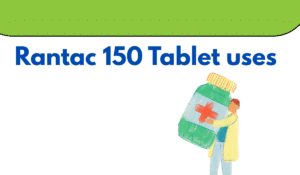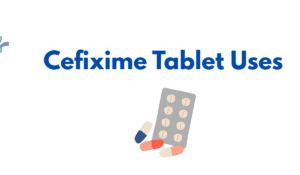Cefixime Tablet Uses :The Unsung Champion of Bacterial Combat
Cefixime Tablet Uses Benefits, Dosage, Side Effects & Precautions Cefixime is a third-generation cephalosporin antibiotic widely prescribed to combat various bacterial infections. Its broad-spectrum efficacy makes it effective against pathogens responsible for respiratory tract infections, urinary tract infections, otitis media, and certain sexually transmitted infections like gonorrhea. By inhibiting bacterial cell wall synthesis, Cefixime disrupts the integrity of bacterial cells, leading to their elimination from the body. Available in multiple formulations, including tablets, chewable tablets, and oral suspensions, it offers flexibility in administration for both adults and children. This article delves into the comprehensive uses of Cefixime, detailing its benefits, recommended dosages, potential side effects, and essential precautions to ensure safe and effective treatm
Introduction
In the vast theatre of microbial warfare, Cefixime emerges as a formidable contender—a cephalosporin-class antibiotic designed to tackle bacterial infections effectively. Renowned for treating a range of acute infections, from ear and throat infections to respiratory and urinary tract issues, Cefixime annihilates bacteria at the cellular level.
How Cefixime Works

The Tactical Blueprint
Cefixime doesn’t merely suppress bacteria—it disarms and destroys them. It works by disrupting the bacteria’s cell wall synthesis, targeting penicillin-binding proteins (PBPs) that are essential for structural integrity. This disruption causes the bacteria to rupture and die.
Broad-Spectrum Efficiency
As a third-generation cephalosporin, Cefixime is effective against both Gram-positive and Gram-negative bacteria. It’s commonly used to treat:
- Gonorrhoea
- Bronchitis
- Tonsillitis
- Ear infections
- Urinary tract infections
Primary Uses of Cefixime
Conditions Treated
Cefixime is commonly prescribed for:
- Respiratory tract infections
- Otitis media (middle ear infections)
- Pharyngitis and tonsillitis
- Urinary tract infections (UTIs)
- Certain sexually transmitted infections (STIs) like gonorrhea
❗ Note: Cefixime does not work against viruses like the common cold or flu. Misuse can contribute to antibiotic resistance.
Dosage and Administration
Standard Protocol
- Adults: 400 mg daily (as a single dose or split into two 200 mg doses)
- Children: Weight-based, typically divided into two doses
Instructions for Use
- Can be taken with or without food
- Chewable tablets must be fully chewed
- Tablets can be split using the scoring line
- Do not stop the course midway even if you feel better
Off-Label Uses
Occasionally, doctors prescribe Cefixime for:
- Typhoid fever
- Shigellosis (Shigella-induced diarrhea)
- Pneumonia (especially if allergic to penicillin)
Always consult your doctor before exploring off-label applications.
Side Effects of Cefixime
Serious Reactions
- Jaundice
- Seizures
- Severe or bloody diarrhea
- Skin discoloration
- Fatigue or confusion
- Severe skin rashes or eye discomfort
Common Side Effects
- Stomach upset
- Vomiting
- Vaginal discharge or irritation
Seek medical help immediately if severe symptoms occur.
Precautions Before Use
Inform your doctor if you:
- Are allergic to penicillin or cephalosporins
- Are pregnant, breastfeeding, or planning pregnancy
- Have kidney or liver issues
- Are receiving live vaccines (e.g., typhoid)
- Suffer from Phenylketonuria (PKU)
- Have a history of antibiotic-triggered diarrhea
Missed Dose & Overdose
Missed a Dose?
Take it as soon as you remember. If your next dose is near, skip the missed one—do not double up.
Overdose Warning
Seek emergency help if symptoms like unconsciousness or breathing trouble appear after an overdose.
Storage and Disposal
- Keep in original, child-proof packaging
- Store in a dry place away from heat and moisture
- Liquid forms may require refrigeration
- Discard unused liquid after 14 days
- Do not flush leftovers—consult a pharmacy for safe disposal
Drug Interactions
Cefixime may interact with:
- Anticonvulsants (e.g., Carbamazepine)
- Blood thinners (e.g., Warfarin, Heparin)
- Methotrexate
- Oral contraceptives
- Probenecid
Also, food, alcohol, and tobacco may affect absorption—ask your doctor for specific instructions.
How Fast Does Cefixime Work?
Cefixime typically begins working within 10 to 30 minutes, but the full effect depends on the severity and location of the infection.
Comparison Table: Cefixime vs. Amoxicillin
| Parameter | Cefixime | Amoxicillin |
| Composition | Contains dibasic calcium phosphate, lactose, titanium dioxide | Amino-penicillin with an added amino group |
| Used For | Gonorrhea, bronchitis, ENT & urinary infections | Dental abscesses, pneumonia, other chest infections |
| Common Side Effects | Indigestion, frequent urination, vaginal discharge | Headache, chills, fever, dizziness |
Frequently Asked Questions (FAQs)
- What does Cefixime treat?
Respiratory, urinary tract infections, and some STIs. - Is Cefixime effective against all bacteria?
No, it depends on the specific bacterial strain. - How should it be taken?
Orally, exactly as directed by your doctor. - Common side effects?
Nausea, loose stools, abdominal cramps, occasional headaches. - When will I feel better?
Symptoms may improve in a few days, but finish the full course. - Which bacteria does it kill?
Streptococcus pneumoniae, Haemophilus influenzae, E. coli, and more. - How many tablets per day?
Typically, 400 mg once or two 200 mg doses per day. - What to avoid?
Avoid antacids containing magnesium/aluminum and alcohol. - Is it liver-friendly?
Generally safe, though liver enzymes may fluctuate. - Is it used for UTIs?
Yes, it’s a common prescription for urinary infections. - Is it safe for the kidneys?
Yes, but dose adjustment might be needed in renal patients. - Can it cause diarrhea?
Yes, and persistent diarrhea should be reported to a doctor. - Is it safe during pregnancy or breastfeeding?
Usually yes, but only under medical supervision.
Conclusion
Cefixime is a powerful antibiotic weapon when used correctly. Its success lies in proper usage, medical supervision, and strict adherence to dosage. While not without side effects, its benefits outweigh the risks in most cases when guided by a healthcare professional.
Disclaimer
This article is for informational purposes only and does not substitute professional medical advice. Always consult a doctor before starting or modifying any medication.







